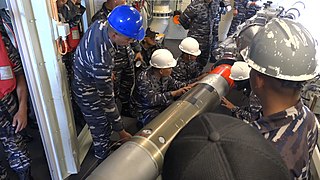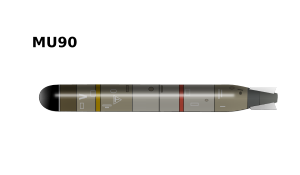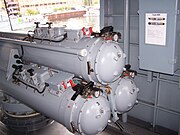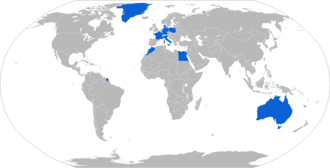
The Mark 46 torpedo is the backbone of the United States Navy's lightweight anti-submarine warfare torpedo inventory and is the NATO standard. These aerial torpedoes are designed to attack high-performance submarines. In 1989, an improvement program for the Mod 5 to the Mod 5A and Mod 5A(S) increased its shallow-water performance. The Mark 46 was initially developed as Research Torpedo Concept I, one of several weapons recommended for implementation by Project Nobska, a 1956 summer study on submarine warfare.

The Anzac class is a ship class of ten frigates; eight operated by the Royal Australian Navy (RAN) and two operated by the Royal New Zealand Navy (RNZN). During the 1980s, the RAN began plans to replace the River-class destroyer escorts with a mid-capability patrol frigate and settled on the idea of modifying a proven German design for Australian conditions. Around the same time, the RNZN was seeking to replace their Leander-class frigates while maintaining blue-water capabilities. A souring of relations between New Zealand and the United States of America in relation to New Zealand's nuclear-free zone and the ANZUS security treaty prompted New Zealand to seek improved ties with other nations, particularly Australia. As both nations were seeking warships of similar capabilities, the decision was made in 1987 to collaborate on their acquisition. The project name is taken from the Australian and New Zealand Army Corps of the First World War.

HMAS Parramatta is an Anzac-class frigate of the Royal Australian Navy (RAN). One of ten warships built for the RAN and Royal New Zealand Navy (RNZN) based on the MEKO 200 design, Parramatta was laid down in 1999, launched in 2003, and commissioned into the RAN in 2003. During her career, the frigate has been deployed to the Middle East on several occasions. In early 2015, Parramatta was docked to undergo the Anti-Ship Missile Defence (ASMD) upgrade. She completed these upgrades in April 2016.

HMAS Stuart is an Anzac-class frigate of the Royal Australian Navy (RAN). She was built at Williamstown in Victoria, and commissioned into the RAN in 2002. The frigate is operational as of 2021.

HMAS Perth is an Anzac-class frigate of the Royal Australian Navy (RAN). The last ship of the class to be completed, she was built by Tenix Defence and commissioned into the RAN in 2006. In 2007, Perth became the first major warship of the RAN to be commanded by a woman. During 2010 and 2011, the frigate was used as the testbed for a major upgrade to the Anzac class' ability to defend themselves from anti-ship missiles.

HMAS Toowoomba is the seventh Anzac-class frigate of the Royal Australian Navy (RAN). She was laid down in 2002 by Tenix Defence and commissioned in 2005.

HMAS Ballarat is an Anzac-class frigate of the Royal Australian Navy (RAN). The frigate was laid down in 2000 and commissioned into the RAN in mid-2004. Since entering service, Ballarat has been involved in border protection as part of Operation Relex II, was deployed to the Gulf for Operation Catalyst, and was one of the two ships involved in the Operation Northern Trident 2009 round-the-world voyage. Ballarat has undergone the Anti-Ship Missile Defence (ASMD) upgrade, completing in 2015.
GEIE EuroTorp is a consortium formed in July 1993 by French and Italian defense companies. Concerned governments signed a memorandum of understanding on industrial co-operation on their new generation lightweight torpedo programs.

The Formidable-class multi-role stealth frigates are multi-mission derivatives of the French Navy's La Fayette-class frigate with the Republic of Singapore Navy. The six ships form the First Flotilla of the Navy.

The Mark 54 Lightweight Torpedo is a standard 12.75-inch (324 mm) anti-submarine warfare (ASW) torpedo used by the United States Navy.

The Sting Ray is a British acoustic homing lightweight torpedo (LWT) manufactured by GEC-Marconi, who were later bought out by BAE Systems. It entered service in 1983.

The Otomat is an anti-ship and coastal defence missile developed by the Italian company Oto Melara jointly with Matra and now made by MBDA. The name comes, for the first versions, from the name of the two builders and, for the later versions, Teseo, from the Italian word for Theseus. The MILAS variant is an anti-submarine missile. In its latest version Mk/2E purchased by the Italian Navy is a medium range anti-ship missile and a ground attack missile.

The A244-s is an Italian lightweight, fire-and-forget torpedo employed for anti-submarine warfare. It can be launched from surface vessels or aircraft and locates the target using an acoustic seeker.
The APR-3E airborne light ASW acoustic homing torpedo is designed by Russian Tactical Missiles Corporation JSC to engage current and future submarines at depth from the surface down to 800 metres at speed of up to 43+ knots, and it is a replacement for earlier APR-2 light antisubmarine acoustic homing torpedo.
The Yu-7 is a lightweight torpedo developed by the People's Republic of China. It entered service in the 1990s as the principal anti-submarine weapon of major People's Liberation Army Navy (PLAN) warships. The Yu-7 is a derivative of the Whitehead Alenia Sistemi Subacquei (WASS) A244/S torpedo.

The Kaman SH-2G Super Seasprite is an American ship-based helicopter with anti-submarine, anti-surface threat capability, including over-the-horizon targeting. This aircraft extends and increases shipboard sensor and weapon capabilities against several types of enemy threats, including submarines of all types, surface ships, and patrol craft that may be armed with anti-ship missiles. It was originally developed for the United States Navy in the 1980s as a reengined and updated version of the older Kaman SH-2 Seasprite which had been serving since the 1960s in a variety of versions, and G model was an evolution of the SH-2F, which was an important ASW aircraft naval vessels that could not manage a larger helicopter. The SH-2G entered service in the 1980s and 90s, and served to 2001 with the U.S. Navy, but went on to serve in several other Naval forces into the 2st Century and is still in active in service in several Navy's.

The Torpedo Advanced Light (TAL) Shyena is the first indigenous advanced lightweight anti-submarine torpedo of India, developed by the Naval Science and Technological Laboratory (NSTL) of the Defence Research and Development Organisation (DRDO) for the Indian Navy. The lightweight torpedo can be launched by ships, submarines, helicopters and previously the now retired Ilyushin Il-38, named after the divine hawk identified with Agni.

The K745 Blue Shark is a light anti-submarine torpedo developed for the Republic of Korea Navy in 2004.
Orka is a new-generation lightweight torpedo developed by Roketsan for the Turkish Navy.


















